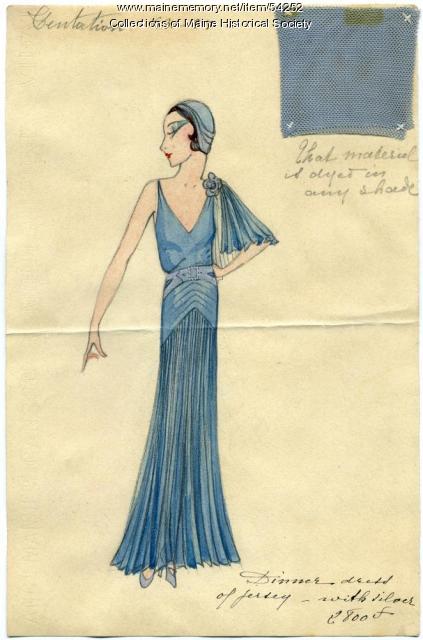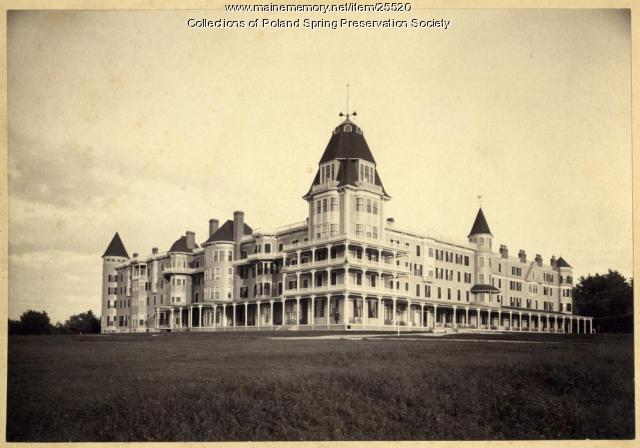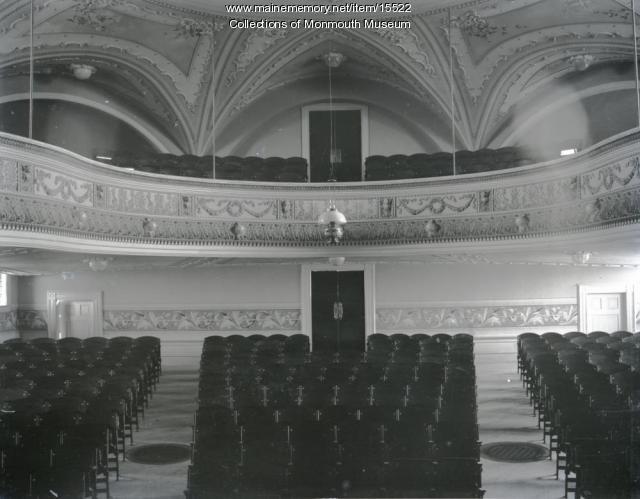Keywords: Fashion
- Historical Items (426)
- Tax Records (0)
- Architecture & Landscape (0)
- Online Exhibits (51)
- Site Pages (292)
- My Maine Stories (10)
- Lesson Plans (4)
Online Exhibits
Your results include these online exhibits. You also can view all of the site's exhibits, view a timeline of selected events in Maine History, and learn how to create your own exhibit. See featured exhibits or create your own exhibit
Exhibit
The mainspring of fashion is the process whereby members of one class imitate the styles of another, who in turn are driven to ever new expedients of fashionable change.
Exhibit
Northern Threads: Early Republic era Fashion dolls
A themed exhibit vignette within "Northern Threads Part I," featuring Early Repulic-era (ca.1780-1820) fashion dolls.
Exhibit
Northern Threads: Mourning Fashions
A themed exhibit vignette within "Northern Threads Part I," featuring 18th and 19th century mourning jewelry and fashions.
Exhibit
Fashionable Maine: early twentieth century clothing
Maine residents kept pace with the dramatic shift in women’s dress that occurred during the short number of years preceding and immediately following World War I. The long restrictive skirts, stiff collars, body molding corsets and formal behavior of earlier decades quickly faded away and the new straight, dropped waist easy-to-wear clothing gave mobility and freedom of movement in tune with the young independent women of the casual, post-war jazz age generation.
Exhibit
Northern Threads: Bustle era fashions
A themed vignette within "Northern Threads Part I," featuring 1870s and 80s era bustle silhouettes.
Exhibit
Fashion for the People: Maine's Graphic Tees
From their humble beginnings as undergarments to today's fashion runways, t-shirts have evolved into universally worn wardrobe staples. Original graphic t-shirts, graphic t-shirt quilts, and photographs trace the 102-year history of the garment, demonstrating how, through the act of wearing graphic tees, people own a part of history relating to politics, social justice, economics, and commemorative events in Maine.
Exhibit
Northern Threads: Two centuries of dress at Maine Historical
Organized by themed vignettes, Northern Threads shares stories about Maine people, while exploring how the clothing they wore reveals social, economic, and environmental histories. This re-examination of Maine Historical Society's permanent collection is an opportunity to consider the relevance of historic clothing in museums, the ebb and flow of fashion styles, and the complexities of diverse representation spanning 200 years of collecting.
Exhibit
Cosmopolitan stylings of Mildred and Madeleine Burrage
Born in Portland, sisters Mildred Giddings Burrage (1890-1983) and Madeleine Burrage (1891-1976) were renowned artists and world travelers. Mildred's experiences studying painting in Paris and Italy, and the sisters' trips to Mexico and Guatemala inspired their artwork and shared passions for cosmopolitan and stylish attire. Housed at Maine Historical Society, The Burrage Papers include selections of original advertising drawings called "line sheets" from Parisian fashion houses dating from 1928 to 1936. Images of Madeleine's gemstone jewelry and Mildred's artwork accompany intimate family photographs of the sisters.
Exhibit
Poland Spring: Summering in Fashion
During the Gilded Age at the end of the nineteenth century, Americans sought to leave increasing urban, industrialized lives for the health and relaxation of the country. The Poland Spring resort, which offered a beautiful setting, healing waters, and many amenities, was one popular destination.
Exhibit
Northern Threads: Outerwear, Militia & Cadet uniforms
A themed vignette within "Northern Threads Part I," featuring 19th century outerwear, bonnets, militia and cadet uniforms.
Exhibit
Northern Threads: Adaptive reuse
A themed vignette within "Northern Threads Part I," featuring up-cycled and reused historic fabrics.
Exhibit
Northern Threads: Civil War-era clothing
An exhibit vignette within "Northern Threads, Part 1," featuring American Civil War civilian and military clothing, 1860 to 1869.
Exhibit
Holding up the Sky: Wabanaki people, culture, history, and art
Learn about Native diplomacy and obligation by exploring 13,000 years of Wabanaki residence in Maine through 17th century treaties, historic items, and contemporary artworks—from ash baskets to high fashion. Wabanaki voices contextualize present-day relevance and repercussions of 400 years of shared histories between Wabanakis and settlers to their region.
Exhibit
Northern Threads: Silhouettes in Sequence, ca. 1780-1889
A themed exhibit vignette within "Northern Threads Part I," featuring a timeline of silhouettes from about 1775 through 1889.
Exhibit
Dressing Up, Standing Out, Fitting In
Adorning oneself to look one's "best" has varied over time, gender, economic class, and by event. Adornments suggest one's sense of identity and one's intent to stand out or fit in.
Exhibit
Northern Threads: The rise and fall of the gigot sleeve
A themed exhibit vignette within "Northern Threads Part I," featuring the balloon-like gigot sleeve of the 1830s.
Exhibit
Toy Len Goon: Mother of the Year
Toy Len Goon of Portland, an immigrant from China, was a widow with six children when she was selected in 1952 as America's Mother of the Year.
Exhibit
Camden has been home to generations of fishermen, shipbuilders, sailmakers, and others who make their living through the sea. The lives of two Camden sailmakers, who were born nearly a century apart, became entwined at a small house on Limerock Street.
Exhibit
Music in Maine - Opera, Orchestras and Stages
"Lillian Blauvelt and Opera Fashion Lillian Blauvelt in Romeo and Juliet, London, 1903Maine Historical Society Lillian Blauvelt's fan, ca."
Exhibit
Northern Threads: Colonial and 19th century fur trade
A vignette in "Northern Threads: Two centuries of dress at Maine Historical Society Part 1," this fur trade mini-exhibition discusses the environmental and economic impact of the fur trade in Maine through the 19th century.
Exhibit
Valentines Day cards have long been a way to express feelings of romance or love for family or friends. These early Valentines Day cards suggest the ways in which the expression of those sentiments has changed over time.
Exhibit
Presque Isle and the Civil War
Presque Isle had fewer than 1,000 residents in 1860, but it still felt the impact of the Civil War. About half of the town's men went off to war. Of those, a third died. The effects of the war were widespread in the small community.
Exhibit
The Taber farm wagon was an innovative design that was popular on New England farms. It made lifting potato barrels onto a wagon easier and made more efficient use of the horse's work. These images glimpse the life work of its inventor, Silas W. Taber of Houlton, and the place of his invention in the farming community
Exhibit
Informal family photos often include family pets -- but formal, studio portraits and paintings also often feature one person and one pet, in formal attire and pose.























